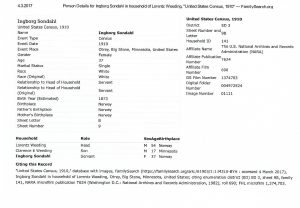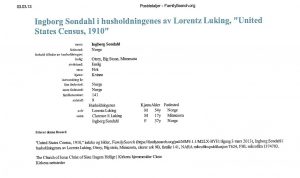Whenever I am working in records or sites from another country – and thus not in the English language – I do my best to leave them in that language, especially if my only option for translation is that which is built into the browser software. A recent consultation request brought this issue front and center.
The request for the consultation was confirmation that the two families the researcher had found in the 1910 census were indeed the same family. At first, I questioned the assumption (and we know what happens then) that he had two actual census pages in which the last name of the family was different.
In fact, what he sent me were two printouts of abstracts from the census. In each family the given names were the same, as were the ages and the location – and in the case of the servant in the household, her name appeared identically on both lists.
*
The 1910 household of Lorintz Weeding (age 54) and his son Clarence E. Weeding (age 17) included a 37-year-old servant named Ingborg Sondaln from Norway. The researcher who wanted the consultation had found a FamilySearch.org abstract of this family (see Figure 1, above). However, he believed that he had found Ingborg Sondaln residing with a suspiciously identical family, except in this instance the surname was not Weeding but Luking (see Figure 2).
In looking at the records the researcher sent I will admit that I was a little confused. In my case, I was concentrating on the names on the two abstracts, breaking one of my own rules about completely reading a document, not just concentrating on the names. I began to question what was going on and went to locate the two households in the original census. I found the Lorintz Weeding family without a problem, but no amount of creative searching brought forth anything with the Luking surname.
Stepping back for a moment I looked again at the two printouts the researcher had shared and realized the abstract of the Lorintz Weeding family from FamilySearch had everything in English – the headings for each part of the abstract and so on. The abstract for the Luking family, on the other hand, was completely in Norwegian (the native tongue of the researcher). It was then that the lightbulb went off in my head and I went off to Google Translate.
I typed in weeding into the English box on Google Translate and asked for the Norwegian equivalent. Google Translate showed me that weeding in Norwegian is luking. It was at that moment that I realized that the “translation” option built into the browser used by the Norwegian researcher had mistaken the surname Weeding as the verb weeding. It had not changed the other names of the members of the household because they were likely not recognizable by the browser as having a Norwegian alternative or, as in Ingborg’s case, were already in Norwegian.
[When] working with a browser’s translation function, it treats all text the same.
Had the researcher used a Norwegian version of FamilySearch this likely would not have happened, because FamilySearch would not have translated the names as abstracted, only the headings. However, when working with a browser’s translation function, it treats all text the same. As such Lorintz Weeding and his son Clarence E. Weeding became Lorintz Luking and Clarence E. Luking, and to the researcher it appeared as though Ingborg Sondaln was in two different but similar families at the same time.
Moral of the story? Try to use built-in browser translation as sparingly as possible, certainly. But, more importantly, always go to the original record.
Share this:
About Rhonda McClure
Rhonda R. McClure, Genealogist, is a nationally recognized professional genealogist and lecturer specializing in New England and celebrity research as well as computerized genealogy; is compiler of more than 120 celebrity family trees; has been a contributing editor for Heritage Quest Magazine, Biography magazine and was a contributor to The History Channel Magazine and American History Magazine. In addition to numerous articles, she is the author of ten books, including the award-winning The Complete Idiot's Guide to Online Genealogy, now in its second edition, Finding Your Famous and Infamous Ancestors, and Digitizing Your Family History.View all posts by Rhonda McClure →

